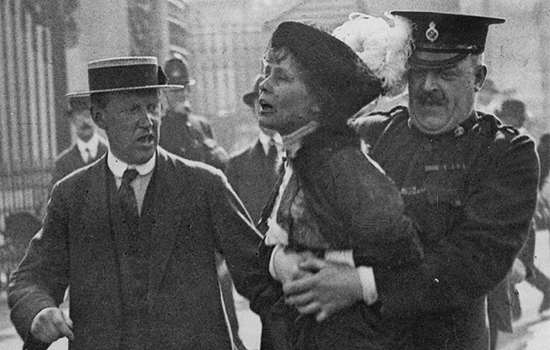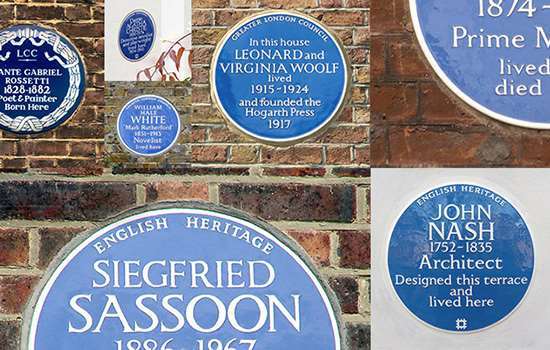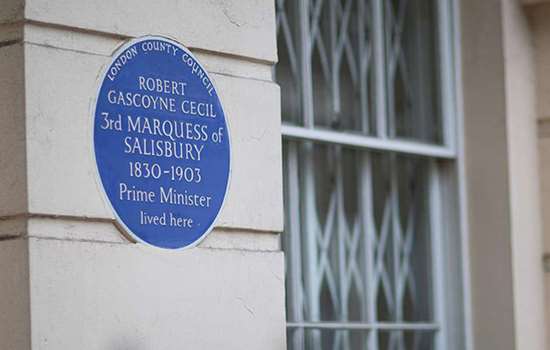JARMAN, Derek (1942-1994)
Plaque erected in 2019 by English Heritage at Butler's Wharf Building, 36 Shad Thames, London, SE1 2YE, London Borough of Southwark
All images © English Heritage
Profession
Film-maker, artist, gay rights campaigner
Category
Philanthropy and Reform, Theatre and Film
Inscription
DEREK JARMAN 1942-1994 Film-maker, artist and gay rights activist lived and worked here
Material
Ceramic
Derek Jarman was a film-maker, artist and gay rights activist who became a major cultural figure in the late 1980s. He is commemorated with a blue plaque at Butler’s Wharf Building in Southwark where he lived and worked from 1973 until 1979.
BUTLER’S WHARF
Derek Jarman was in the early stages of his film career when he moved into Butler’s Wharf Building, a large, linear warehouse on the south bank of the Thames. He lived and worked in a studio on the third floor of block A1 at the east end of the building from May 1973 until July 1979, though he was forced to rent out the space in 1974–6 and 1978 to raise funds. While there he held film evenings and used the empty plot next door for spontaneous filming sessions with friends. His second feature film, Jubilee (1978), was also produced at his Butler’s Wharf studio.
His neighbours included the sculptor Peter Logan on the two top floors of block A1, and Peter’s brother, the artist Andrew Logan in Block B. Andrew’s studio hosted one of the very first gigs of the newly-formed Sex Pistols in 1976, as well as the Alternative Miss World Contest. Jarman, dressed as Miss Crêpe Suzette, won the contest in 1975 in front of a judging panel that included David Hockney.
FILM CAREER
Jarman was a maverick film-maker, whose art house works often portrayed historical homosexual figures and captured the political zeitgeist of Thatcher-era Britain. His first feature film, Sebastiane (1976), is loosely based on the legend of St Sebastian and features homoerotic relationships between Sebastian and his fellow soldiers. Jarman continued to explore male homosexual experience in his later films The Angelic Conversion (1985), Caravaggio (1986) and Edward II (1991).
His political films include The Tempest (1979), which focuses on themes of enslavement, imprisonment and banishment and concludes with singer Elisabeth Welch appearing as a goddess and crooning ‘Stormy Weather’ to a room of prancing sailors. The Last of England (1987) starred Tilda Swinton in a meditation on the country’s change and decline, and became one of his best known works.
GAY RIGHTS ACTIVISM
Jarman was a prominent figure in OutRage!, a gay rights activist group that took a more anti-establishment stance than Stonewall. He campaigned for the repeal of section 28 of the Local Government Bill (1987), which banned local authorities from ‘promoting homosexuality’, and in 1987 he publicly announced that he was HIV positive just one month after his diagnosis. He was one of the first public figures in the UK to talk openly about his illness in an era when HIV was often referred to in derogatory terms.
It was partly for health reasons that Jarman moved in 1987 to Prospect Cottage in Dungeness, Kent, with his partner, Keith Collins. While there he developed a unique garden in the inhospitable environment, and wrote about it and the experience of living with AIDS in the influential Modern Nature (1991).
Jarman died of bronchopneumonia at St Bartholomew's Hospital, London, on 19 February 1994 and was buried in St Clement's churchyard, New Romney, Kent.


